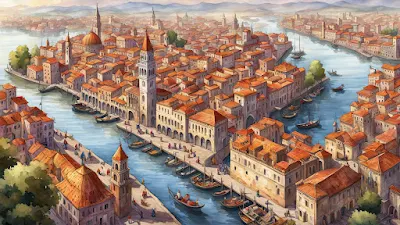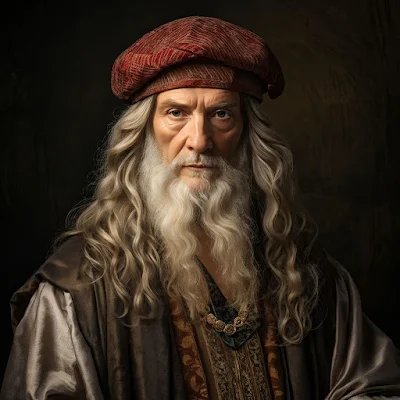Renaissance Art: A Comprehensive Guide to the Masterpieces and Influences of the Era
Introduction to Renaissance Art
The Renaissance, a period of cultural rebirth, marked
a pivotal moment in European history. Spanning from the 14th to the 17th
century, this era saw a resurgence of interest in the classical ideals of
ancient Greece and Rome. This revival wasn't just about a return to old ideas;
it was about innovating and blending the old with the new. Renaissance Art is
one of the most significant outcomes of this period, revolutionizing the way
artists approached their craft, resulting in some of the most iconic artworks
in history.
The Birth of Renaissance Art
The term "Renaissance" means
"rebirth," and this was a time when art blossomed like never before.
Artists of the Renaissance sought to capture the human experience in a way that
was realistic, emotional, and expressive. Unlike the flat and symbolic art of
the medieval period, Renaissance artists focused on perspective, proportion,
and anatomy. This new approach to art began in Italy, particularly in cities
like Florence, Venice, and Rome, before spreading across Europe.
Key Artists and Their Masterpieces
Renaissance Art is often associated with a few key
figures who revolutionized artistic techniques and left behind a legacy that
continues to influence artists today. Here are some of the most notable artists
and their works:
Leonardo da Vinci:
Perhaps the most famous Renaissance artist, Leonardo was a master of many
disciplines, including painting, sculpture, and engineering. His works, such as
the "Mona Lisa" and "The Last Supper," are renowned for
their intricate detail, use of perspective, and deep emotional resonance.
Michelangelo Buonarroti:
Known for his stunning sculptures like "David" and "Pietà,"
as well as his breathtaking frescoes in the Sistine Chapel, Michelangelo’s work
exemplifies the Renaissance ideal of human beauty and spiritual expression.
Raphael Sanzio:
Raphael’s "School of Athens" is a masterpiece that embodies the
Renaissance spirit, depicting a gathering of great thinkers from history in a
harmonious and balanced composition.
Sandro Botticelli:
His painting "The Birth of Venus" is iconic for its portrayal of
classical mythology with a sense of grace and beauty that became a hallmark of
Renaissance Art.
The Impact of Humanism on Renaissance Art
One of the driving forces behind Renaissance Art was
the philosophy of humanism. This intellectual movement emphasized the value of
human beings, the study of classical texts, and a focus on the here and now
rather than the afterlife. Humanism encouraged artists to explore new subjects,
including portraiture, landscapes, and scenes from everyday life, rather than
purely religious themes. This shift allowed for a more diverse range of
artistic expression and innovation.
Techniques and Innovations
Renaissance artists developed and refined techniques
that changed the course of art history. Some of the most important innovations
include:
Perspective:
The use of linear perspective allowed artists to create the illusion of depth
and space, making their works more realistic and three-dimensional.
Chiaroscuro:
This technique involved the use of strong contrasts between light and dark to
give the illusion of volume and solidity to figures and objects.
Sfumato: Pioneered by
Leonardo da Vinci, sfumato is a technique of blending colors and tones subtly,
without abrupt transitions, creating a more lifelike image.
Anatomy: Renaissance
artists studied the human body in great detail, often dissecting cadavers to
understand muscle structure and movement, which led to more accurate and
dynamic depictions of the human form.
The Influence of Patronage
The Renaissance period saw a significant rise in the
patronage of the arts. Wealthy families like the Medici of Florence, as well as
the Catholic Church, played a crucial role in funding and commissioning works
of art. This financial support allowed artists to focus on their work and
experiment with new techniques and ideas. Patronage also ensured that the most
talented artists could gain the recognition and resources they needed to
produce their masterpieces.
The Legacy of Renaissance Art
The Renaissance period set the stage for the modern
era of art. The techniques, themes, and ideas developed during this time
influenced countless generations of artists. Renaissance Art also helped to
elevate the status of the artist from a mere craftsman to a creative genius,
capable of shaping culture and history.
Advantages of Renaissance Art
Realism and Humanism
Renaissance art brought a shift towards realism, where artists sought to depict the human body and nature as accurately as possible. This emphasis on realism, driven by humanism, led to more lifelike and emotional representations in art. The use of techniques like chiaroscuro (the contrast between light and dark) and linear perspective allowed for a more three-dimensional appearance, making art more engaging and relatable.Revival of Classical Ideals
The Renaissance revived classical Greek and Roman ideals, focusing on symmetry, proportion, and harmony. This revival not only enhanced the aesthetic appeal of artworks but also contributed to the development of architectural marvels, such as the dome of Florence Cathedral by Brunelleschi, which combined classical elements with innovative engineering techniques.Advancement of Artistic Techniques
The Renaissance period was a time of significant innovation in artistic techniques. Artists like Leonardo da Vinci and Michelangelo mastered the use of sfumato (a technique of blending colors and tones), fresco painting, and oil painting, which allowed for greater detail, depth, and vibrancy in their works. These techniques have influenced generations of artists and remain foundational in art education today.Cultural and Intellectual Growth
Renaissance art was not just about aesthetics; it was deeply intertwined with the intellectual currents of the time. The focus on humanism promoted individualism and the pursuit of knowledge, leading to a flourishing of literature, philosophy, and science. Artists like da Vinci exemplified the "Renaissance man," excelling in multiple fields and contributing to a broader cultural and intellectual growth.Disadvantages of Renaissance Art
Exclusivity and Elitism
One of the significant disadvantages of Renaissance art was its exclusivity. The movement was primarily centered in Italy and was often patronized by the wealthy and powerful, such as the Medici family. This meant that the benefits of Renaissance art and its intellectual advancements were not accessible to the general population. The art was often created for private collections or churches, limiting public access.Overemphasis on Classical Ideals
While the revival of classical ideals was a hallmark of the Renaissance, it also led to an overemphasis on Greco-Roman themes and aesthetics. This focus sometimes stifled creativity, as artists felt pressured to conform to these ideals rather than explore new and diverse cultural influences. This could be seen as a limitation, as it restricted the artistic expression to a narrow set of themes and styles.Religious and Political Tensions
Renaissance art was often deeply tied to religious themes and commissioned by the Church. However, this close relationship also led to tensions, especially during the Protestant Reformation, where religious imagery became a point of contention. The art of this period could be used as a tool for religious propaganda, leading to conflicts and divisions within society.The Impact of Plague and Wars
The Renaissance period was also marked by significant challenges, including the Black Death and various wars. These events disrupted artistic production and led to the destruction of many artworks. The instability of the time meant that not all artists could flourish, and many potential masterpieces were lost to history.Conclusion
Renaissance Art is more than just a style; it
represents a cultural and intellectual awakening that changed the way people
saw the world. The masterpieces created during this period continue to inspire
and captivate audiences around the globe. By understanding the key elements and
figures of Renaissance Art, we gain a deeper appreciation for this pivotal era
in human history.
FAQ
1. What is Renaissance Art?
Renaissance Art refers to the art produced during the Renaissance, a period in European history from the 14th to the 17th century. This art movement is characterized by a revival of classical learning and wisdom, the development of new artistic techniques, and a focus on realism, humanism, and the human experience.
2. Why is the Renaissance period called the "rebirth"?
The Renaissance is termed the "rebirth" because it marked a renewed interest in the art, culture, and philosophies of ancient Greece and Rome. This period was seen as a revival of classical knowledge and an awakening after the so-called "Dark Ages" of the medieval period.
3. Who are the most famous artists of the Renaissance?
Some of the most renowned Renaissance artists include Leonardo da Vinci, Michelangelo Buonarroti, Raphael Sanzio, and Sandro Botticelli. These artists are celebrated for their contributions to painting, sculpture, and architecture, and their works remain iconic to this day.
4. What are some famous works of Renaissance Art?
Notable works of Renaissance Art include Leonardo da Vinci's "Mona Lisa" and "The Last Supper," Michelangelo's sculptures "David" and "Pietà," Raphael's "School of Athens," and Botticelli's "The Birth of Venus."
5. How did Renaissance Art differ from medieval art?
Renaissance Art differed from medieval art in its focus on realism, the use of perspective, and the exploration of human anatomy and emotion. While medieval art was more symbolic and religious, Renaissance artists sought to depict the natural world and human beings more accurately and expressively.
6. What role did humanism play in Renaissance Art?
Humanism, a key intellectual movement of the Renaissance, emphasized the value and potential of human beings and the study of classical antiquity. In art, this translated into a greater focus on individualism, the human form, and secular subjects, moving beyond the predominantly religious themes of the medieval period.
7. What are some key techniques used in Renaissance Art?
Renaissance artists introduced and perfected several techniques, including linear perspective (to create depth), chiaroscuro (the use of light and shadow to create volume), and sfumato (the blending of colors and tones for a softer effect). These innovations allowed for more realistic and three-dimensional representations in art.
8. How did patronage influence Renaissance Art?
Patronage played a significant role in the development of Renaissance Art. Wealthy families, such as the Medici, and institutions like the Catholic Church, funded artists and commissioned works. This support provided artists with the resources and freedom to experiment and create some of their most famous pieces.
9. Why is Leonardo da Vinci considered a Renaissance man?
Leonardo da Vinci is often referred to as a "Renaissance man" because of his wide-ranging talents and interests. He was not only an artist but also an inventor, scientist, and engineer. His curiosity and creativity embodied the Renaissance ideal of pursuing knowledge across various fields.
10. How did Renaissance Art influence modern art?
Renaissance Art laid the foundation for many modern artistic techniques and ideas. The emphasis on realism, humanism, and the use of perspective continued to influence artists for centuries. The Renaissance also helped to elevate the status of artists, setting the stage for the development of art as a respected and vital cultural force.





